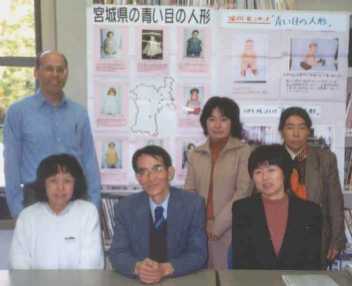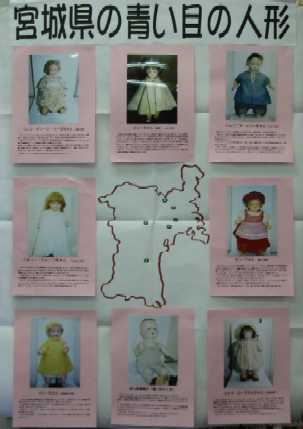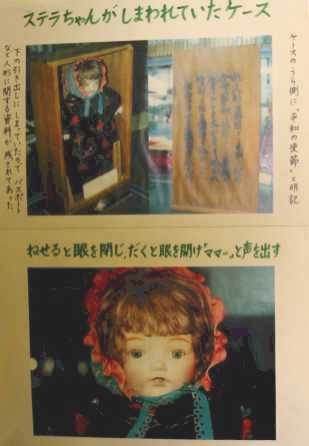|
|
|

|

|
Miyagi Blue-eyed Doll
Study Group
|
|
|
The Miyagi Blue-eyed Doll Study Group promotes
educational activities and performs research related to the Blue-eyed Dolls
sent to Japan from America in 1927. The group has about 30 members, and about
10 members attend the monthly meetings. Many members are current or retired
teachers, and several members belong to the Miyagi Co-op, which provides
active support to the Study Group.
In February 1999, several members of the group
created a web page on the six
Blue-eyed Dolls in Miyagi Prefecture that had been found up to that time.
Through the efforts of the Miyagi Blue-eyed Doll Study Group, eight dolls
have now been found in Miyagi Prefecture, which received a total of 221 dolls
from America in 1927.
The Miyagi Blue-eyed Doll Study Group has
prepared many materials for educational activities in schools in Miyagi
Prefecture. The group has researched the history of each of the eight dolls
in Miyagi, and the members have put together posters and photos that can be used in
presentations to students. This fall the group coordinated a special
three-month exhibition at Sendai Historical Museum of seven of the eight dolls in
Miyagi Prefecture.
|
|
|

|
|
Blue-eyed Dolls of
Miyagi Prefecture
|

|
|
|
I never realized that a group such as the Miyagi Blue-eyed Doll Study
Group existed until I received an e-mail in October, one month before my
planned visits to three schools in Miyagi Prefecture. Ms. Toshiko Saito,
who had retired in March 2001 after teaching for many years at Hirobuchi
Elementary School, found out that I would be visiting the school on
November 13 to talk about the Friendship Dolls and about America. She told
the other members of the Study Group about my planned visit, so Ms. Tomoko
Shizukuishi, another member of the group, contacted me by e-mail and
kindly offered to coordinate my visit to the different schools in Miyagi.
She also arranged for me to visit two other elementary schools and to meet
with the members of the group at a special meeting at the Sendai
Historical Museum. Ms. Shizukuishi accompanied me to each of the five
schools I visited in Miyagi, and Ms. Saito also went with me to the three
schools I visited on November 13. In addition, Mr. Shuji Sato of the
Miyagi Co-op Cultural Activities Office kindly drove me to the two schools
I visited on November 12.
In the evening on November 13, three
members of the Study Group treated me to dinner at a gourmet tofu
restaurant. I did not know quite what to expect at a tofu restaurant,
since I had never been to one before. The meal consisted of about 15
different tofu dishes brought out by the waitress one or two at a time. I
never realized tofu could be cooked in so many ways, with the tofu in the
separate dishes having different consistency and color. The food was quite
delicious!
|
|
|
|
|

|

|
Presentation Material About
Stella, the Blue-eyed Doll
at Hirobuchi Kindergarten
|
|
|
Before the November 14th meeting of the Miyagi
Blue-eyed Doll Group, I met with the Director of the Sendai Historical Museum
and a member of the staff, who took me on a tour of the museum. That morning
the museum was filled with elementary school children viewing the various
exhibits and busily taking notes for school projects. One very interesting
exhibit was a sugoroku (Japanese variety of Parcheesi) game board,
which was made during World War II and which showed various drawings of
wartime scenes and objects.
During the Study Group meeting I talked about
the experiences during my visits to the five Miyagi schools in the previous
two days. We also exchanged some photos and historical newspaper articles
related to the Friendship Dolls. The group members discussed the possibility of a
homecoming to Japan for Miss Miyagi, the Japanese Friendship Doll sent to
America in 1927, but they realized that raising the necessary funds would be a
challenge. I talked a little bit about my web site on Friendship Dolls and how
I hoped it could be a source where teachers and others could learn about the dolls
exchanged between America and Japan for the purpose of friendship and peace.
|
|
|